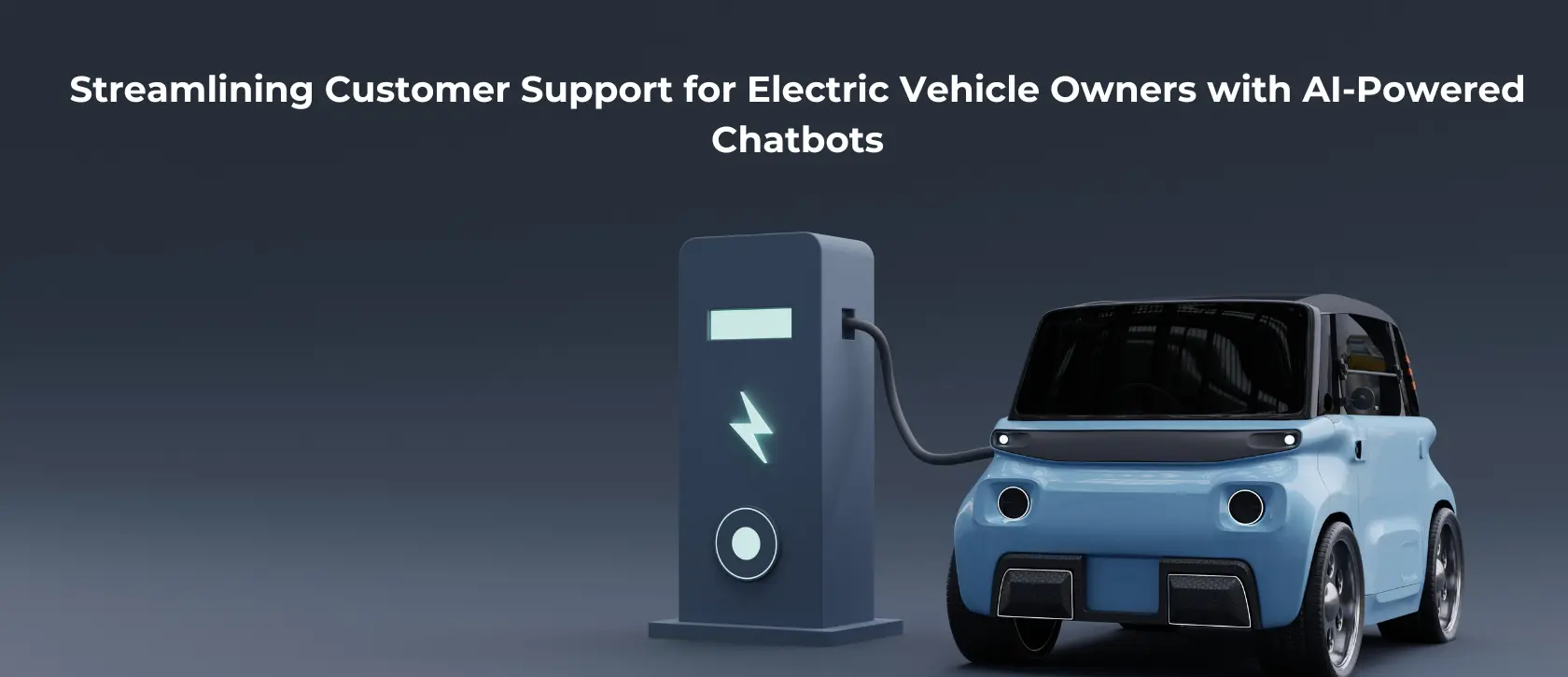
Streamlining Customer Support for Electric Vehicle Owners with AI-Powered Chatbots
The electric vehicle (EV) industry is rapidly evolving, with more consumers shifting toward sustainable transportation. However, as EV adoption grows, so does the demand for robust customer support to assist owners with a range of issues from technical inquiries to real-time troubleshooting. In this landscape, traditional customer service methods can fail to deliver fall short of delivering timely and efficient support. Enter AI-powered chatbots advanced, automated systems that are revolutionizing customer support for EV owners.
These AI-driven virtual assistants are designed to provide seamless, personalized, and rapid responses to queries, transforming the customer service experience. In this blog, we’ll explore the key features of AI-powered chatbots in EV customer support and how they streamline the customer journey
Features of AI-Powered Chatbots in EV Customer Support
1. Instantaneous Query Resolution
AI-powered chatbots can instantly resolve common queries related to EV ownership. From understanding how to charge the vehicle to interpreting dashboard indicators, chatbots provide immediate and accurate responses without the wait times associated with traditional customer service methods. This is particularly valuable in critical situations where EV owners may require urgent assistance, such as during charging station errors or software glitches.
Example: A driver on a road trip encounters a charging error at a station. Instead of waiting in a queue for customer support, they use the chatbot integrated into their EV app, which guides them through a quick reset process, saving valuable time.
2. Integration with Vehicle Systems
The next level of customer support is when chatbots are directly integrated with vehicle systems. This allows chatbots to offer real-time insights into vehicle performance, battery health, and even predictive maintenance needs. With this integration, chatbots can diagnose issues based on vehicle data, offer troubleshooting advice, and schedule repairs or maintenance when needed.
Example: An EV owner’s battery shows unexpected degradation. The chatbot, connected to the vehicle’s diagnostics system, alerts the owner to the issue and suggests scheduling a maintenance check. It can even recommend nearby service centers that specialize in battery optimization.
3. Seamless Handover to Human Agents
While AI chatbots excel at handling routine and straightforward inquiries, there are instances where human intervention is required especially for complex technical problems. A critical feature of AI-powered chatbots is their ability to seamlessly escalate such issues to human agents without disrupting the customer experience. When this happens, all previous communication is transferred to the agent, ensuring a smooth transition without needing the need for the customer to repeat their issue.
Example: An owner reports erratic charging behavior. After gathering initial data from the vehicle, the chatbot recognizes the problem’s complexity and immediately escalates the case to a human technician. The technician is fully briefed and ready to resolve the issue.
4. Proactive Customer Engagement
Proactive engagement means reaching out to customers before they encounter problems. AI-powered chatbots can analyze data from the vehicle to predict potential issues and notify the owner of preventive measures. This helps improve customer satisfaction by addressing issues before they become bigger problems.
Example: The chatbot detects that an EV’s software is due for an update and proactively notifies the owner. It also provides easy-to-follow instructions or offers to schedule a time when the vehicle can automatically download and install the update, thus minimizing downtime.
5. Continuous Learning and Improvement
One of the strengths of AI-powered chatbots is their ability to learn and evolve. As more customers interact with the system, the chatbot continually improves its responses, making future interactions smoother and more accurate. Through machine learning, chatbots can identify new types of inquiries, refine their understanding of complex issues, and offer more personalized support based on past interactions.
Example: Over time, the chatbot notices that multiple users are reporting a specific issue with a new model of the EV. By recognizing the pattern, the chatbot informs the manufacturer of a potential design flaw, contributing to product improvement and more accurate future responses.
6. Automated Appointment Management
Gone are the days of lengthy phone calls to schedule service appointments. AI chatbots streamline this process by automatically booking appointments for EV owners based on their schedules and the availability of service centers. Chatbots can also send reminders and updates, making the entire process hassle-free.
Example: After detecting an issue with the vehicle’s charging system, the chatbot offers to book an appointment at the nearest service center. The owner selects a convenient time, and the appointment is confirmed within seconds, complete with reminders closer to the service date.
Benefits of AI-Powered Chatbots for EV Owners
1. Personalized Driving and Charging Tips
AI-powered chatbots can offer personalized driving and charging tips based on an individual’s driving habits and real-time data from the vehicle. By analyzing patterns such as the frequency of trips, average speed, and battery consumption, the chatbot can suggest ways to optimize driving and charging routines, maximizing efficiency and battery life.
Example: A driver who regularly commutes long distances receives tailored advice on minimizing battery drain, such as maintaining a consistent speed or charging during non-peak hours to extend battery life and reduce electricity costs.
2. Proactive Support and Notifications
One of the standout benefits of AI chatbots is their ability to offer proactive support. Chatbots can notify owners about potential issues before they escalate, such as upcoming maintenance or required software updates, ensuring that the vehicle remains in optimal condition.
Example: A chatbot detects abnormal tire pressure readings and immediately alerts the driver, suggesting a visit to the nearest service station. The owner receives the message before the situation worsens, preventing potential damage or safety risks.
3. 24/7 Support Availability
Unlike traditional customer service, which operates within business hours, AI-powered chatbots provide round-the-clock support. This 24/7 availability ensures that EV owners can access help anytime, whether it’s troubleshooting a charging station late at night or seeking quick advice during a long road trip.
Example: A driver who faces difficulty with charging at 11 p.m. turns to the chatbot for instant assistance. The chatbot quickly walks them through the steps to resolve the issue, ensuring the vehicle is ready for the next day.
4. User-Friendly Assistance for New EV Owners
For individuals new to electric vehicles, the learning curve can be steep. AI-powered chatbots offer user-friendly guidance to help new owners understand their vehicle’s features, navigate charging stations, and maintain the vehicle properly. This personalized assistance helps ease the transition from traditional vehicles to EVs.
Example: A first-time EV owner, unsure of how regenerative braking works, asks the chatbot. The chatbot provides a clear and simple explanation, along with tips on how to maximize energy recovery during drives.
5. Quick Access to Vehicle Manuals and Guides
Gone are the days of searching through thick vehicle manuals. AI-powered chatbots provide instant access to specific sections of the vehicle manual or offer step-by-step guides for common tasks. This quick access allows owners to find the information they need without hassle, directly from their smartphone or vehicle display.
Example: An EV owner needs to recalibrate the tire pressure sensors but is unsure how. Instead of flipping through the manual, they ask the chatbot, which provides immediate instructions, helping them complete the task quickly.
6. Simplified Troubleshooting
AI-powered chatbots streamline the troubleshooting process by guiding users through quick diagnostic steps to identify and resolve issues without needing to contact human support. If the problem is too complex, the chatbot can escalate the issue to a human agent, armed with a clear understanding of the issue for faster resolution.
Example: A driver encounters an unexpected dashboard warning light. The chatbot walks them through a diagnostic sequence, identifying that the issue is a minor software glitch that can be resolved by restarting the vehicle’s system, avoiding an unnecessary trip to the service center.
AI-powered chatbots offer a myriad of benefits for electric vehicle owners, from personalized driving advice to 24/7 support, ensuring a seamless and stress-free experience. Whether it’s providing proactive notifications or simplifying troubleshooting, chatbots make owning and maintaining an EV easier and more convenient. As AI technology continues to advance, these chatbots will play an increasingly vital role in shaping the future of customer support for electric vehicle owners, ensuring that every drive is efficient, safe, and enjoyable.





